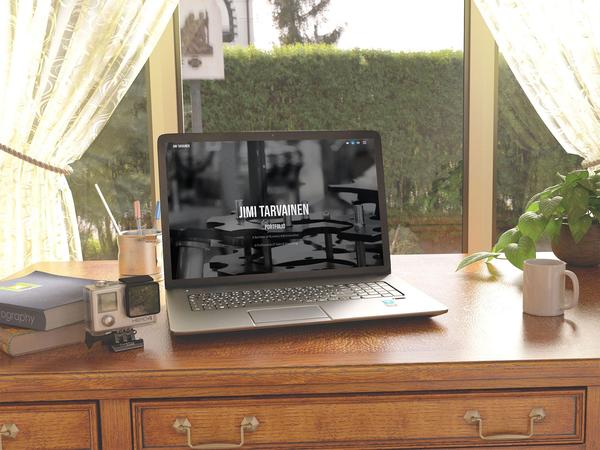
How to Build an Awesome Technical Writing Portfolio and 5 Excellent Examples

Jessica Michael
Published onThe technical writing industry continues to grow, with technical writing jobs on the increase. The U.S. Bureau of Labor Statistics lists the median salary of a technical writer in the U.S as $78,060 per year, with higher wages for senior technical writers with more experience. Many technical writers work remotely and have good opportunities for career advancement. This makes it a great career choice, but it also means there's quite a bit of competition. In order to stand out, you're going to need an impressive portfolio. Luckily, we're here to help you learn how to build a technical writing portfolio that can get you hired.
What is a technical writer?
Technical writing involves taking complex information and breaking it down into easy-to-understand formats such as guides, manuals, technical materials, and white papers. Technical writers are subject matter experts who often have a background in the industry they write about, including engineering, computer programming, or healthcare management. Many technical writers work in-house creating documents that help end users navigate a particular technology. Most technical writing is designed for the company's or organization's internal use, helping employees utilize a systems platform or summarizing performance reports for C-Suite executives.
What is a technical writing portfolio?
A technical writing portfolio is a collection of samples of your technical writing projects as well as information about you that a prospective employer might want to know. Professional experience, education, and any technical writing certificates you've earned might be included. These days, most writing portfolios are digital and are often hosted on digital portfolio sites or created as websites. Technical writing portfolios tend to be more professional and straightforward than other writing portfolios and include more details about educational and professional background. They're designed so that an employer can access examples of your work easily and evaluate quickly if you're a good fit for the role.
The importance of a technical writing portfolio
Most technical writers work as employees at larger companies and organizations, although some are able to freelance. Whether you are looking to get hired in-house or you need freelance clients, a portfolio is the most effective way to showcase your technical writing, highlight your skillset, and present your educational background and career experience. In fact, many potential employers require a digital portfolio as part of the hiring process. Having a well-designed and professional looking portfolio that emphasizes your best work is a must-have if you want to impress potential employers or clients.
What to include in a technical writing portfolio
Digital portfolios are a chance to emphasize your unique qualifications. And while there is always room to show some personality, technical writing portfolios are professional in tone and simple in design. A good portfolio includes:
Technical writing samples. The most important part of your portfolio is your samples. This is what employers and clients are going to spend the most time on because your examples of technical writing speak directly to your abilities. For that reason, you'll want to balance including enough samples to show depth of experience with being sure to include the absolute best of what you've done. You can include all of your best work on a featured projects page, or if you have experience in multiple areas, you may want to display each type of content on a separate page. And if you're just starting out and don't have enough examples of your work, don't worry. We'll address that further along in this article.
Biographical information. Biographical information is divided into two types: personal and professional. In a technical writer's portfolio, you'll want to accentuate your professional experience, but that doesn't mean you can't also include some interesting personal facts as well. The best way to judge if you should include a personal fact is to decide if it would be appropriate to share that piece of information in a job interview. Your About Me can be a section or a page, and you can keep it short by separately featuring educational and work experience, or you can include all of your information in your bio.
Resume/CV. Technical writing often requires subject matter expertise, either from a career background in a subject or an educational background in that subject. Including your resume really helps to boost your authority, and can be done by featuring that information on its own page, in a widget, or with a button that links to a document. Whatever you choose, make sure it's easy for someone to find, and if you have any special training in technical writing, be sure to include that, too.
Contact Information. Contact information includes a contact form that can be on a separate page or located at the bottom of your landing page, as well as any social media buttons you wish to include. Social media access is more important if you are also advertising that you write social media posts or run social media campaigns, but many employers now also check social accounts. LinkedIn can be especially useful, but be sure you only link accounts that will help your chances of getting hired. You may also want to display your email in your sidebar or header as well.
Senior level technical writing portfolio
If you have a ton of experience and are designing a portfolio to upscale into a better position, a resume becomes an even more important component of your portfolio. Since you'll have more projects to choose from, only include your most impressive samples. We also recommend testimonials from previous clients and employers. Sticking to a more professional tone and simple design aesthetic can help to underline your impressive abilities and background.
Entry level technical writing portfolio
If you're just breaking into becoming a technical writer, figuring out how to build a technical writing portfolio with no experience can seem intimidating. It's important to have an excellent portfolio with professional design, because it will often be your first impression and can convince someone to take a chance on you. Spend more time on your educational and career background sections and make your About Me interesting and personable. Don't be afraid to include samples of your other types of writing work. And create a multitude of "mock" sample projects (many technical writing certificate programs will have you create these). As long as you define them as mock samples, they're a great way to show your potential.
5 Technical Writing Portfolio Examples We Love
1. Marcus Taylor
View Marcus' portfolio here: www.mtwriting.com
Marcus Taylor is a technical writer and thought leader who specializes in Healthcare IT, SaaS, cloud computing, machine learning, agile development and data privacy. Marcus showcases his impressive experience by starting his portfolio with his bio. He highlights his areas of expertise as well as his publishing history in heavy-hitters like Forbes, Hacker Noon, and Tech Radar. Four beautiful button images mirror his nav bar and link to an About page, a Portfolio page, a Contact page, and his full resume. Marcus succeeds in maximizing the impact of formidable experience by including easy-to-read text on his About and Resume pages. He balances this with a Portfolio page in a sleek grid design that allows a site visitor to look up an article by title or by type of content (press release, healthcare, public policy, event materials, etc). This allows potential clients to key into exactly the type of work sample they'd like to see from him.
What we like best: Marcus knows he has the experience to back up his technical writing, and he makes sure to show that in his portfolio in several different ways. You don't need to resort to gimmicks if your work speaks for itself.
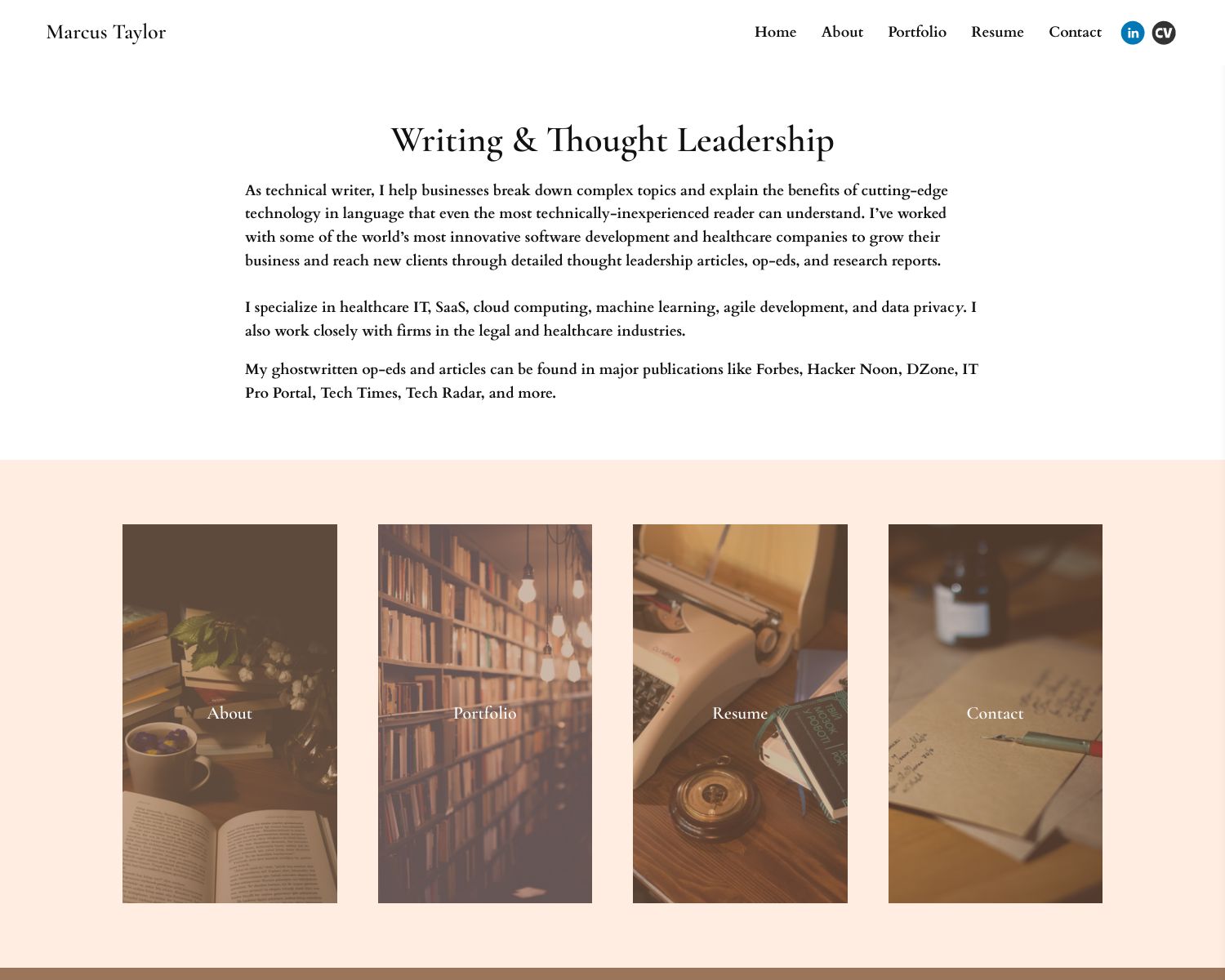
2. SaDesia Giles
SaDesia Giles is a ServiceNow technical writer. SaDesia's landing page features a welcoming bio pic and short About section. A primarily black and white design with large faded image headers creates a professional and understated aesthetic. Her two-column education page features photos of her diplomas and certificates alongside descriptions which give her a chance to emphasize her abilities. She utilizes a grid layout on a projects page, with simple graphic images that link to each project in full. Future clients can easily view her work while getting to know more about her background.
What we like best: SaDesia underscores her great qualifications, from education to experience, while still managing a welcoming tone. You can maintain professionalism while also giving a sense of who you are.
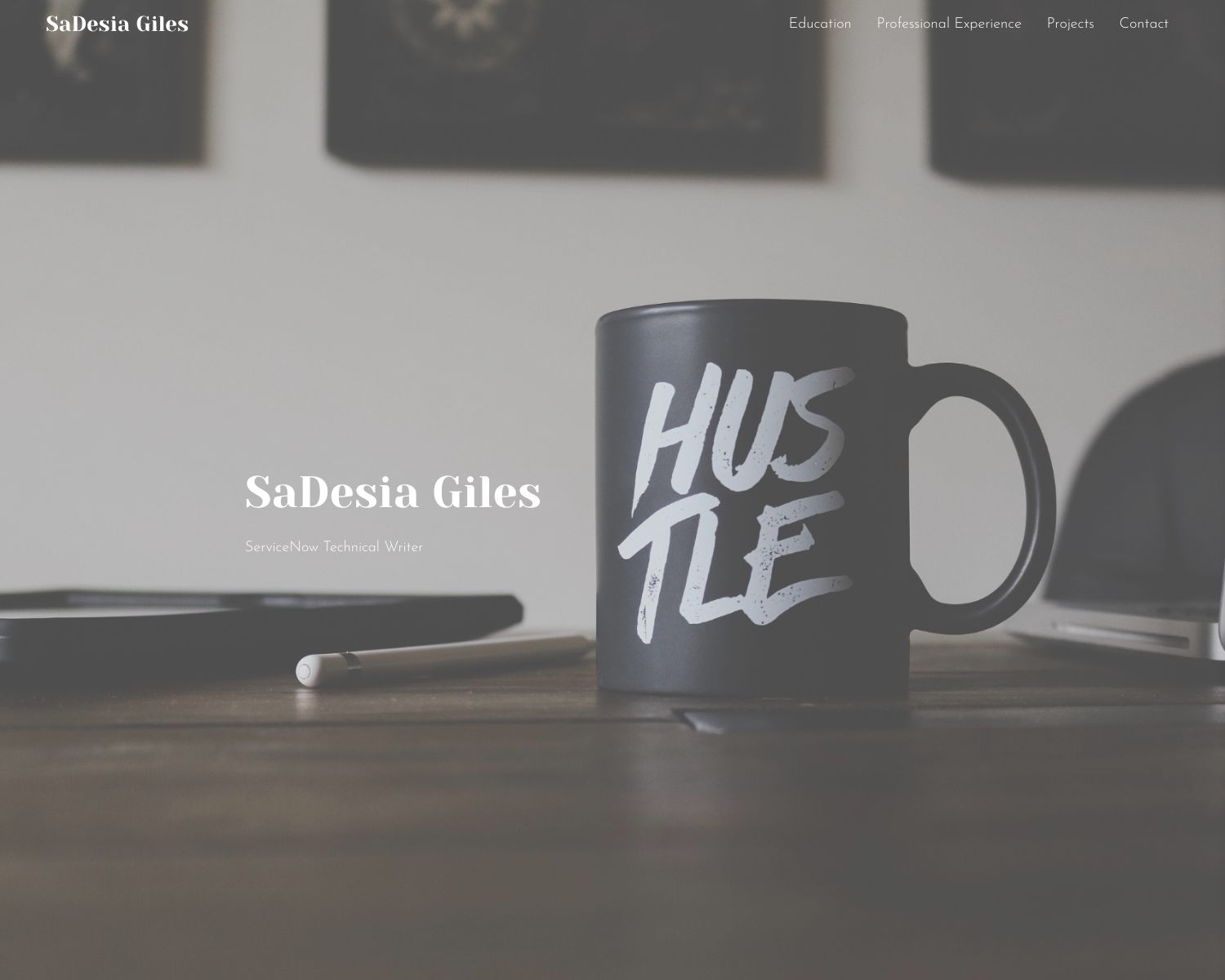
3. Dustin Lewis
View Dustin's portfolio here: www.bydustinlewis.com
Dustin Lewis is a technical writer who also specializes in UX writing and advertising. His two-page website design immediately hits you with his featured work on his landing page. Large image buttons lead to a dialogue box that summarizes each project and allows the user to choose whether or not to view it in its entirety. His black header packs a motto with a punch, an example of his copywriting skills in itself. He keeps the black as his background on his second page, with a more casual About Me section and a friendly picture, beneath which you can easily find his contact form.
What we like best: Including a dialogue box with a project summary lets future clients decide how much of each individual project they want to see. It gives them plenty of information without making them dig through every sample.

4. Marie Daland
View Marie's portfolio here: www.mariedaland.com
Marie Daland is a senior-level copywriter, content strategist, and technical writer. Marie's layout makes great use of her nav bar, dividing her site into pages that each highlight a different type of content. Her header is repeated across her site's pages and includes a professional profile pic, a subscribe button for her email list, and a menu of social media buttons so you can follow her on any platform. Each page sports a dark gray background with a grid layout that features the best samples of her work in each content area. She includes more than enough samples to impress without overly cluttering the page. Her About page cleverly integrates a widget that lets an interested client view her resume right on the page.
What we like best: Your portfolio is also a reflection of your personal brand. By including social media, subscribe options, and smartly incorporated widgets, you become more than the sum of your work samples.
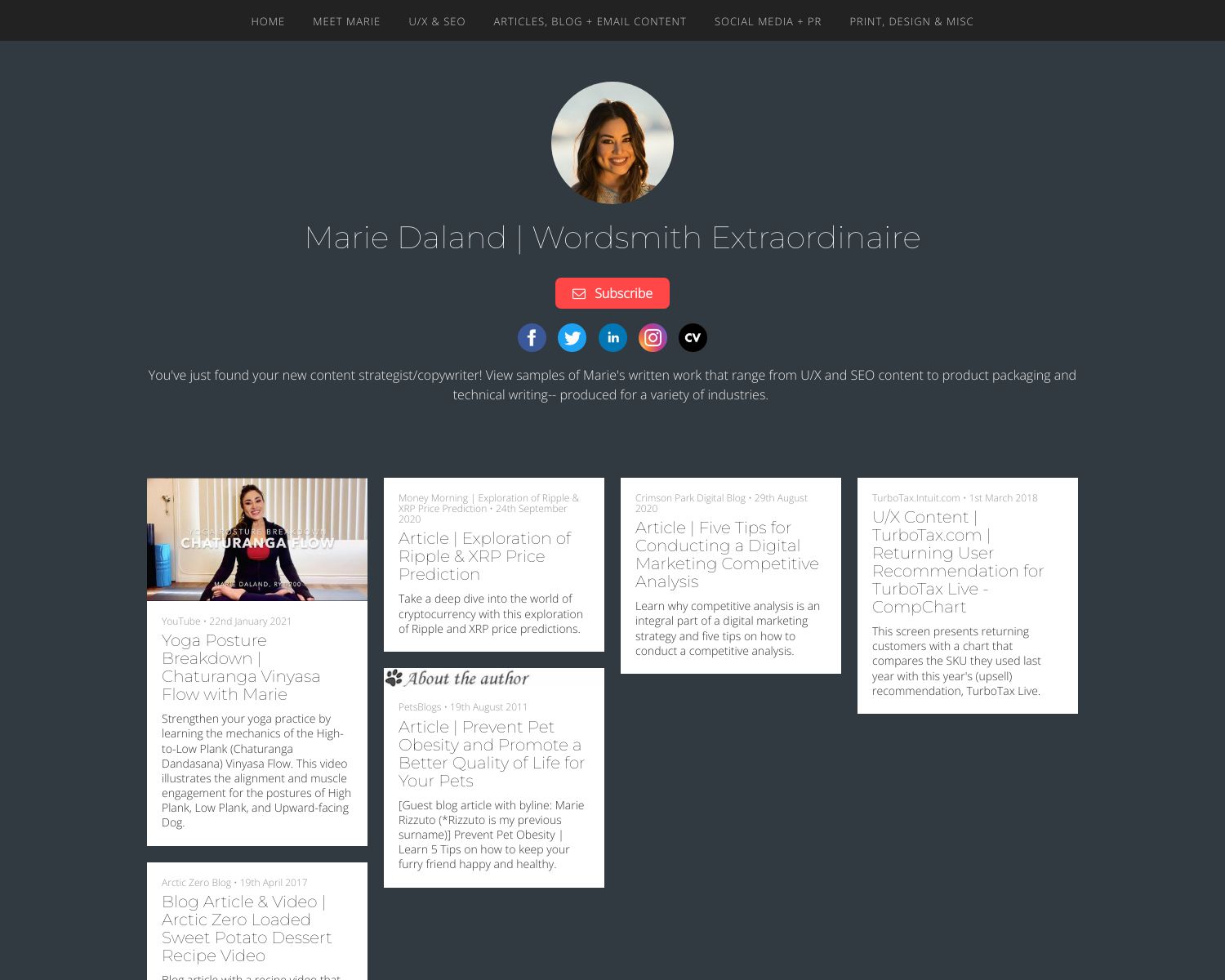
5. Helen Abbott
View Helen's portfolio here: www.helenjabbott.com
Helen Abbott is a technical writer with more than 20 years of experience. Helen chooses a light gray background with header text in red, creating a simple but impactful color scheme. Her side bar includes a bio pic, her social media buttons, and a nav menu that divides her site into "Work" and "Play" pages. She keeps this nav bar across all pages so the site remains easy to navigate wherever you land. A grid layout spotlights her work samples which emphasize only her best examples. And her "Play" pages feature her audio recordings on SoundCloud and her YouTube music videos.
What we like best: Think beyond the usual social media buttons. If you have a presence on other platforms, it can help to round out an employer's impression of you by including them, as long as the content would be considered appropriate in a professional setting.
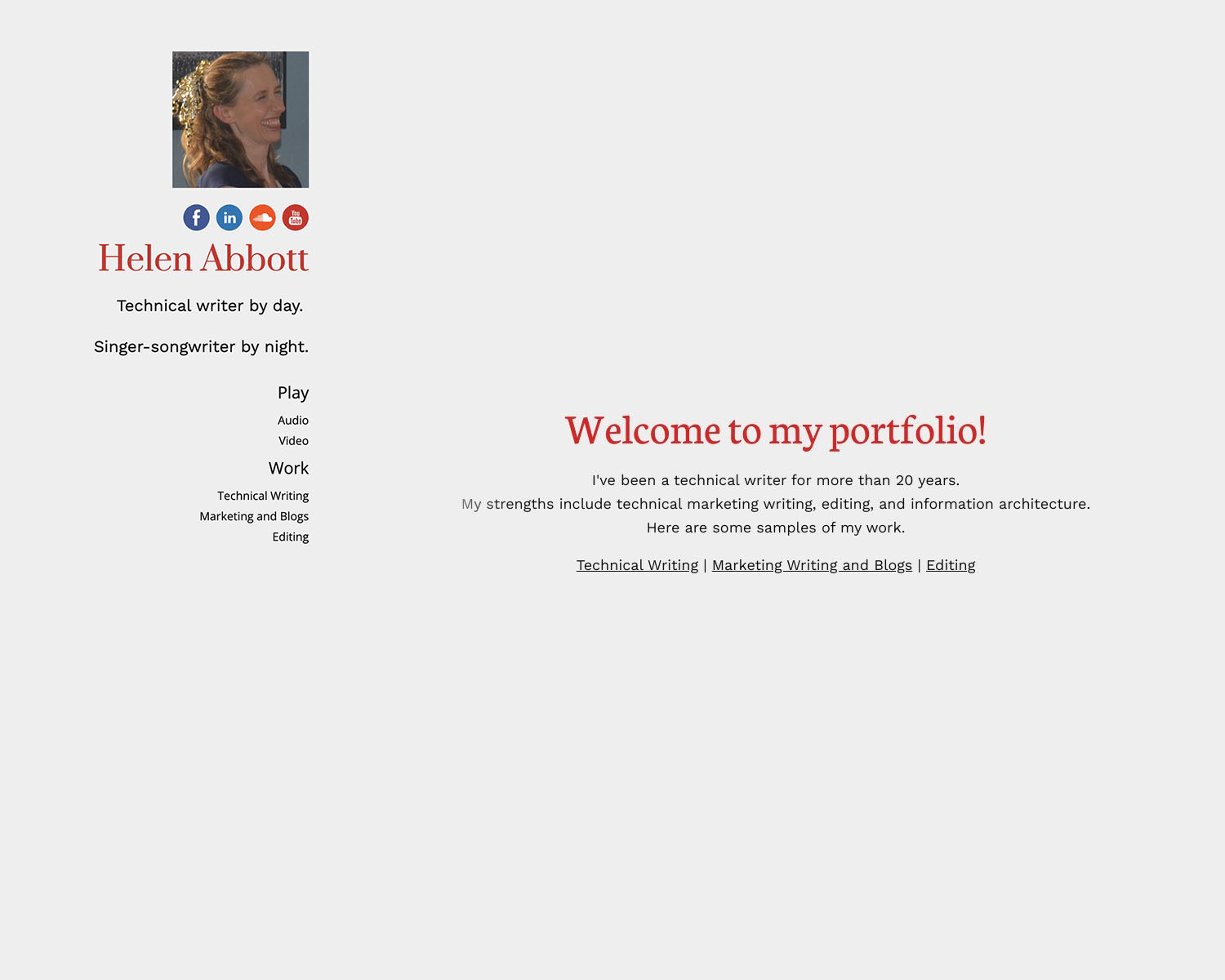
It's your turn to build a technical writing portfolio
Now that you know the basics of what to include in a technical writing portfolio, and you've seen some different examples to inspire you, it's time to get to work on your own portfolio. First, gather up your best work samples and decide how you want to organize them. (Tip: Journo Portfolio makes this easy with embedded tags that let users search your samples by category.) Next, browse templates to get an idea of what design you want for your portfolio. Now you're ready to upload and create a technical writing portfolio to impress.\ Building a technical writing portfolio doesn't have to be overwhelming or take a lot of time. Journo Portfolio's user interface makes it easy and fast to design a professional digital portfolio that's guaranteed to get you noticed. Browse our templates today to get started!
